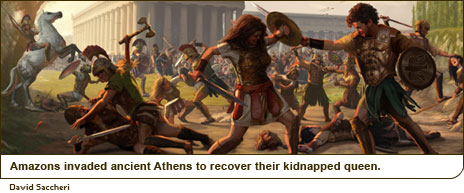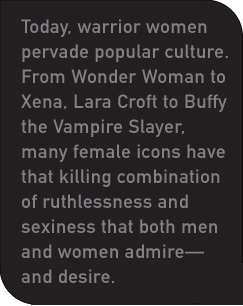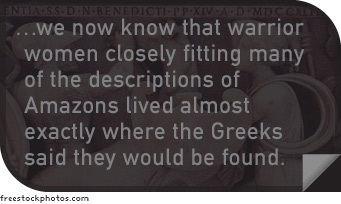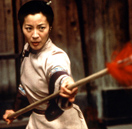
Golden-shielded, silver-sworded, man-loving, male-child-slaughtering Amazons...
—Hellanicus
The Amazons galloped onto the stage of history in the pages of Homer, who called them “women the equal of men.”

The legendary group of women was well recorded by ancient Greeks in history and mythology. Herodotus described them as descendants of shipwrecked Greek women and Scythian men. Other Greek writers embellished the details, describing ferocious fighters and skilled horsewomen who cut off one breast in order to shoot arrows better. According to legend, Amazons abhorred men and lived in women-only communities, taking lovers once a year to procreate. Male offspring were given away, lamed or slaughtered. Themiscyra, their capital city, was rumored to be located on the Black Sea coast (near present-day Samsun, in northern Turkey), but Amazons were also associated with the goddess-worshipping city of Ephesus on the Aegean coast (now western Turkey).
Amazons were feared and admired for their athletic beauty, and their images survive in ancient art. The most prominent Amazons include Penthesilea, who fought Achilles in the Trojan War; Antiope, won in a raid by Theseus and taken away to be his concubine (the Amazons invaded Athens to get her back, but they were defeated); and Myrina, queen of a race of African Amazons. (Diodorus claimed that Myrina’s rule predated the Amazons of Themiscyra, and that it was she who sailed north to Greece and founded many of the Amazon cities.)
But Amazons are not found only in museums and the pages of Greek mythology. The term “Amazon” has been used loosely throughout history to describe various sorts of fighting women, including a group who lived on the Amazon River in South America. The notion of an all-female nation of warlike women has served as a source of fascination for many cultures, including our own. Today, warrior women pervade popular culture. From Wonder Woman to Xena, Lara Croft to Buffy the Vampire Slayer, many female icons have that killing combination of ruthlessness and sexiness that both men and women admire—and desire.
 Did the magnificent women who inspired the
“Amazon” archetype really exist? Or are these ancient Greek heroines merely mythical creatures? Until recently, the accepted theory was that the patriarchal Greeks invented the Amazons as a way of showing the infinite superiority of males: Sure, women could ride, fight and kill like men, but they could never win.
Did the magnificent women who inspired the
“Amazon” archetype really exist? Or are these ancient Greek heroines merely mythical creatures? Until recently, the accepted theory was that the patriarchal Greeks invented the Amazons as a way of showing the infinite superiority of males: Sure, women could ride, fight and kill like men, but they could never win.
On vases, the Amazons are depicted much like another enemy of the Greeks, the Persians-skimpy, smooth-cheeked creatures wearing spotted trousers and pointy Phrygian caps. Greeks, on the other hand, are pictured half-naked, beautiful and, above all, ultra-macho. Some scholars claim that the Amazon myths were designed to show that reversing the “natural” (which in ancient Greece meant male-dominated) order would always lead to disaster.
But in the second half of the twentieth century, archaeologists Renate Rolle and Jeannine Davis-Kimball separately uncovered evidence that challenged this theory. In the steppe-land surrounding the Black Sea (now Ukraine and Russia), they discovered graves of women buried with classically female accoutrements as well as weapons such as bows and arrows, daggers and swords. Excited scientists determined that these women were Sauromatians or Scythians, nomadic horse-riding races named by Herodotus as part of the Amazons’ ancestry.
Finally, archaeologists had evidence that warrior women existed in an area where Greek authors situated some of the original Amazons. But these Iron Age kurgans (grave mounds) also contained skeletons of men and children—a major departure from the Amazons of Greek legend, who were Oiorpata (man killers) that lived apart from men. Rolle uncovered one grave that contained a young woman with a baby on her breast. The remains left little doubt that the woman was a warrior (the finger bones of her bow-pulling hand were worn and weapons were found by her side). These warlike women could have served as the basis for the Amazon myth, but with some other characteristics thrown in by the Greek authors for good measure—such as man killing and separatism. But where might these more dramatic aspects of the Amazonian legend have come from?
Here are some possible clues: Hittite texts (many still not translated) contain stories set in the same territory where Themiscyra was said to be located. These tales detail groups of priestesses who were feared for their magical prowess, spells and power over men. Moving west geographically, on the Aegean coast there were temples to Artemis where priestesses performed war dances and male acolytes castrated themselves in honor of the goddess.  Old texts also mention temples to Artemis where priestesses sacrificed shipwrecked sailors to their ferocious goddess by hurling them over cliffs.
Old texts also mention temples to Artemis where priestesses sacrificed shipwrecked sailors to their ferocious goddess by hurling them over cliffs.
Any of these stories could have resulted in the man-killer legend, and perhaps a combination of the fighting skills of the Scythian nomad-women and the male-terrifying magic of the Hittite and Greek priestesses led to the emergence of the mythical Amazon.
While archaeologists have not yet unearthed an all-female nation of warrior women that precisely accords with depictions in Greek history and mythology, we now know that warrior women closely fitting many of the descriptions of Amazons lived almost exactly where the Greeks said they would be found. These very real women fought and died in battle, shooting arrows and taking the lives of their enemies just as surely as they nurtured new life, suckling infants at their breasts. Whether these were the very same women the Greeks revered as the “golden-shielded, silver-sworded” Amazons may never be known. But it is likely they served as inspiration for the ancient Greeks, as well as for the 2,500 years of historians and artists that followed them, making the archetype of the Amazons one of the most enduring themes of Western civilization.
:: Lyn Webster Wilde
Amazons Selected Sources







